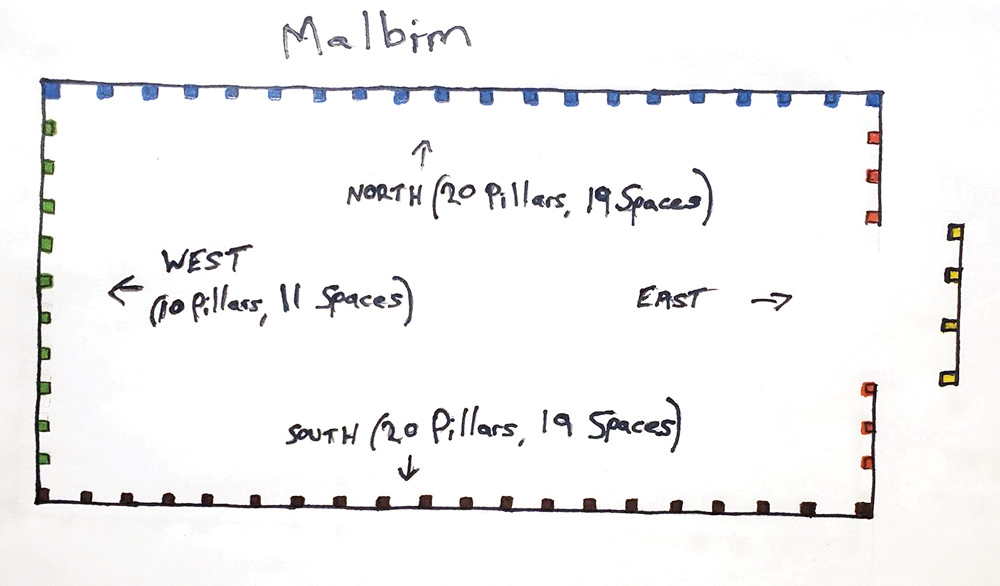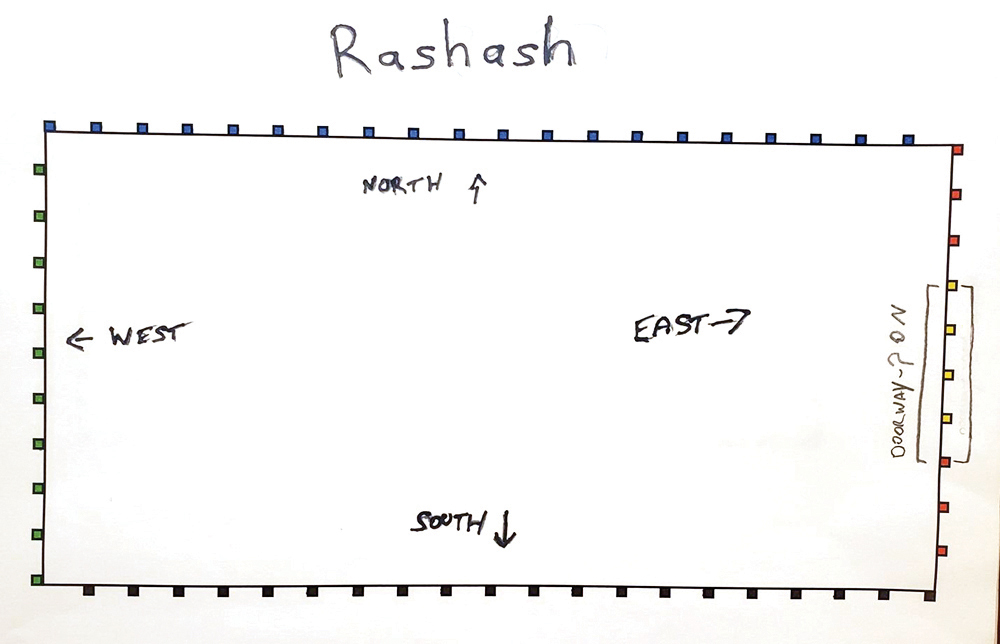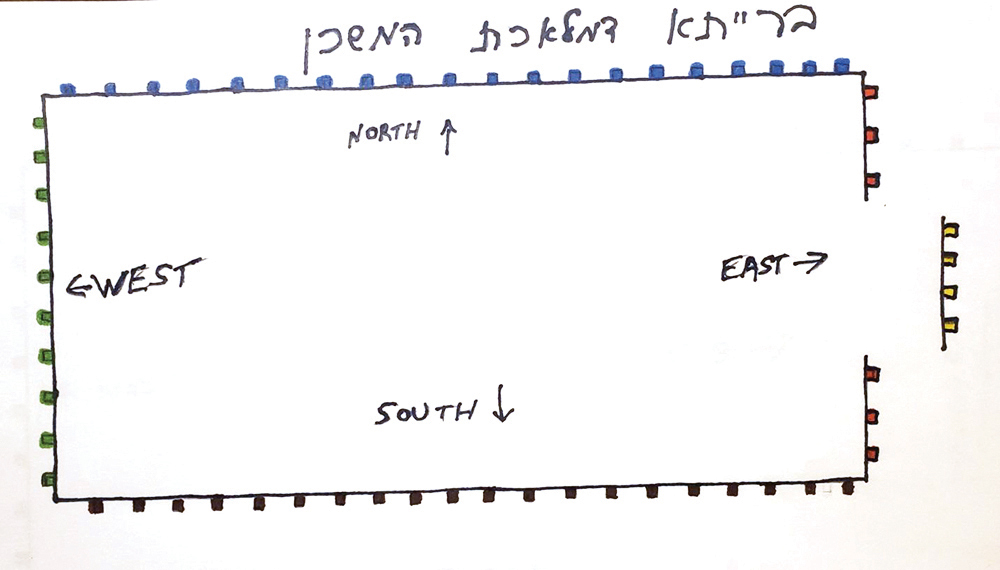
The courtyard of the Mishkan was 100 אמות long and 50 אמות wide (Shemos 27:18), with the perimeter (besides the entranceway) enclosed by קלעים (lace-like hangings) supported by pillars. The precise location of these pillars has been the subject of much discussion, with good reason, as the math doesn’t seem to work. For example, the southern side is 100 אמות long, with 20 pillars (27:9-11) and five אמות between pillars (Rashi on 27:10, based on Braysa d’Meleches HaMishkan 5:3). Since there are only 19 spaces between 20 pillars, we are short five ( אמות 19×5=95), minus the width of one pillar (each of the 19 five-אמה stretches includes one pillar, so the width of the 20th pillar can be added to the 95 אמות). How do we account for the missing אמות?
Abarbanel and Rabbeini Ephrayim (quoted by Riv”a) suggest that the width of the pillars were not included in each five-אמה stretch, and should be added to the total. If each pillar was a quarter אמה wide, the missing five אמות have been found (20/4=5). However, there are several issues with this approach.
For one thing, this only works for the north and south sides. The west side was 50 אמות long, with 10 pillars (27:12), so the 9 spaces between the 10 pillars only account for 45 אמות. If the pillars were all the same size, they only compensate for half the missing אמות. And if these 10 pillars were between the ones in the southwest and northwest corners—so there are 12 pillars on the west side with 11 spaces—we now have 55 אמות of קלעים) 11×5=55) plus three אמות of pillars (12/4=3), which is 8 אמות too many!

Abarbanel says the 9 spaces between pillars on the west side were 5 1/3 אמות each, for a total of 48 אמות, plus 2 אמות for the pillars (although it should be 2.5, with the spaces slightly less than 5.3). Riv”a says the pillars on the west side were twice as wide as those on the north and south sides, so the 5 אמות were compensated for with half the number of pillars. Malbim uses the corner pillars, and says there were 11 spaces between the 12 pillars on the west side, with less than 5 אמות per space.
The 15-אמה shoulders on the east side (27:14-15) would have similar issues. While Malbim is somewhat consistent, using the corner pillars to help provide three spaces with the three additional pillars of each shoulder, Abarbanel does the same, despite not using the corner pillars on the west side. Both have the three spaces, including the pillars, being 5 אמות each (unlike the north and south sides, where the 5 אמות were aside from the width of the pillars). Abarbanel says the 20-אמה entranceway, which has four pillars (27:16), also has three spaces, with each space being 6 1/3 אמות, plus one אמה for the width of the pillars. Although Malbim discusses whether the entrance was flush with the shoulders or 10 אמות east of the courtyard, if there were 12 pillars on the east side, the math only works if the מסך is separate from the shoulders.
The inconsistency in the spacing and/or pillar width is not the only thing that makes this approach less than ideal. Why wouldn’t the 5-אמה measurement include the pillars’ width (on all sides, not just the shoulders), since the קלעים cover the pillars too? Why give such a measurement if it’s not consistent? It could be suggested that the קלעים hung between the pillars, with the pillars themselves showing on both sides (which would be an interesting design), but the Torah strongly implies that the 50 or 100 אמות on each side refers to the קלעים themselves.

The commentators on Rashi (e.g. Mizrachi and Gur Aryeh) suggest that the missing five אמות on each side is a misnomer, as the corner pillars support the corner קלעים on two sides, while only counting towards one. So, for example, the 21st pillar on the south side is also the 1st pillar on the west side, but attributed only to the west side. By completing the rectangle, there are 20 spaces on the south and north sides, and 10 spaces on the west and east sides, with a total of 60 pillars.
This approach has issues as well. First of all, these commentators say the pillars were inside the courtyard itself, which means the corner pillars are part of both the length and the width of the courtyard. Assuming (as they do) that each pillar was one אמה wide, either the length of the קלעים was really 101 אמות (and the width 51 אמות) or, even though most sections were 5 אמות including one pillar (with 4 אמות between pillars), the corner sections were 5 אמות including two pillars (with only 3 אמות between pillars). This issue is alleviated if the pillars were outside the courtyard (which is how Rashash, Shemos Rabbah 35:6, explains it), as the width of the corner pillars only touched the קלעים on one side, even though they supported the קלעים on two sides.
Another issue is the doorway on the east side, which Braysa d’Meleches HaMishkan (5:4) says was 10 אמות east of the courtyard. The rectangle is no longer closed, so the shoulders’ pillars can’t support the מסך that covered the doorway, nor can one of the pillars of the מסך support a shoulder. The commentators address this issue by claiming that the configuration of the doorway as described by BdMhM is not universally accepted (based on whether the מסך would be lifted to allow entry). [I would think either way it would be preferable not to have to lift the מסך in order to get in or out.]

As far as how to distinguish which side a corner pillar was attributed to, there are several possibilities. If the pillars were outside the קלעים, the corner pillars weren’t in line with both sides (only one), so you can tell which side it was really on. Although most assume that the אדנים (bases) for the pillars surrounded the bottom of the pillars evenly on all sides (with the bottoms shaved to fit inside so that the אדנים didn’t protrude), Maharil Diskin says on one side they did protrude, with the protrusion facing the next pillar in the row. For example, on the southern side, the protrusion of the pillar in the southeastern corner faced the next pillar on the southern side, i.e. west, with the protrusion of all the southern pillars facing west. The protrusion of the 21st pillar, on the other hand, faced north, so could be identified with the rest of the western pillars, whose protrusion also faced north. חכמת המשכן suggests that the corner pillars were attributed to both sides they were adjacent to, but only as half a pillar for each side. So even though the southern side had 21 pillars, it really had 19 and two halves. [None of these will help distinguish between a pillar of a shoulder and of the מסך.]
The BdMhM (5:3) says each 5-אמה section of the קלעים was attached to its corresponding pillar from its center, with 2.5 אמות extending from each side. If the pillars closest to the corners were 2.5 אמות off the corner, or, to be more exact, 2 אמות off the corner (with their center 2.5 אמות off the corner), we only need 20 pillars for the south side (et al). What needs to be dealt with, though, is how the corners were supported (since there were no pillars in the actual corners), as well as how the קלעים of the shoulders next to the doorway (and the ends of the מסך) stayed up.
מעשה חושב (in 5:6) suggests there were wooden poles on top of the hooks that the קלעים were hung on, extending to both ends of the east and west sides, which supported the קלעים in the corners of the courtyard. This would also explain how the edges of the shoulders stayed up. (If there was a similar pole on top of the hooks of the pillars of the מסך, its ends would stay up the same way.) Although these poles aren’t mentioned in the Torah, neither are the קונדסין that Rashi describes (27:10, based on BdMhM 5:3) when explaining how the קלעים were hung from the pillars.

[In 5:5, מעשה חושב suggested that the corners were cut diagonally, with the קלעים supported by the pillars closest to the corner. However, since the pillars ended 2 אמות off the corner, the diagonal section of the קלעים between the two pillars would be just under 3 אמות, not 5 אמות. Additionally, there would no longer be 100 or 50 אמות of קלעים on each side. Besides, this would only explain how the corners stayed up; if the מסך was not flush with the shoulders, it wouldn’t explain how they stayed up.]
I wonder whether the thickness of the linen קלעים, especially after the tops were wrapped around the קונדסין before they were hung, would keep the top edges stiff enough to not need the support of a pillar. And even though I am uncomfortable with the spacing of the קלעים not being consistent throughout, I am okay with the מסך, being separate from the קלעים, having three sections that are 6 2/3 אמות each, supported by four independent pillars (although the poles make more sense).
Rabbi Dov Kramer isn’t convinced that Rashi understood the layout of the pillars the way the מפרשי רש»י say he did. He prefers the approach of the ברייתא דמלאכת המשכן, but is unsure whether Rashi did as well. Which layout do you prefer?
RabbiDMK at gmail.com.












